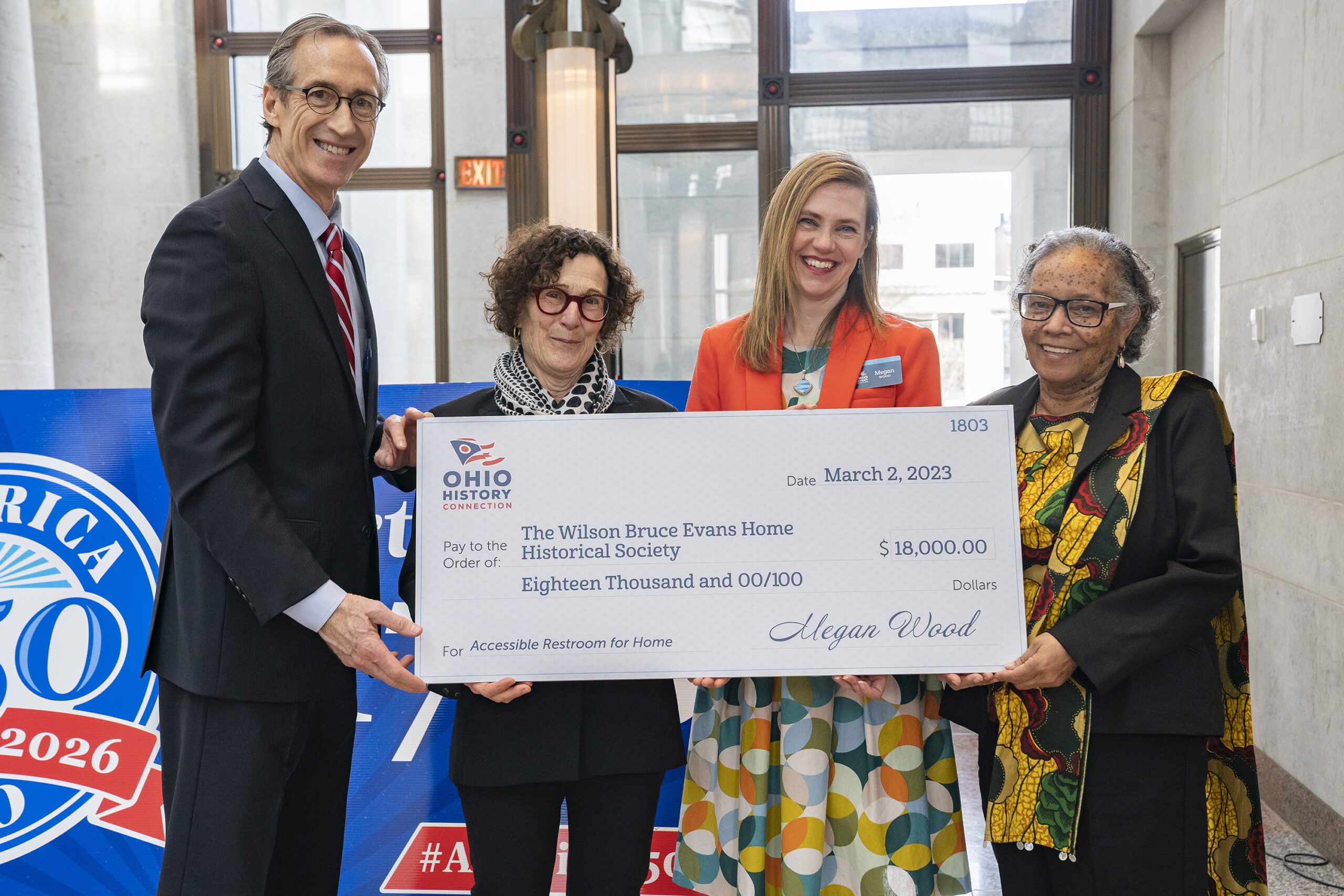Applying for a Grant
Eligible projects fall into one of three grant categories: Bricks & Mortar, Organizational Development, and Programs & Collections. History Fund grants are competitive and require matching funds, goods, and/or services from recipients. Experts from history-related organizations across Ohio review applications and make grant recommendations. The Ohio History Connection administers the History Fund program.
Before you create an account and begin your application, read the Ohio History Fund Grant Guidelines and grant Do’s and Don’ts list.
The Guidelines
- Delineate professional standards and best practices that projects must follow
- Spell out eligibility requirements for applicants and projects.
- List the program’s three grant categories and describe the types of projects eligible under each. The three categories are Bricks & Mortar, Organizational Development, and Programs & Collections.
- State minimum and maximum grant award amounts
- Outline match requirements
- Stipulate durations of projects
This list will help you make your application as competitive as you can. Following these tips will help you avoid obstacles that could hurt your chances of getting a grant.
History Fund Webinars
Want more information? Our prerecorded webinars can help. The "History Fund Help - Overview of Application" webinar is an introduction to the grant program and a detailed overview of the grant application. The "Digitization Nuts and Bolts" webinar will help you compile a strong application for a digitization project (it's more than buying a scanner). We originally hosted both webinars in 2016. The format of the application has changed since then, but the information in the webinar still applies.
This webinar consists of three parts: a survey of the Ohio History Fund's grant guidelines, an overview of the actual online grant application, and answers to common questions. The overview of the online grant application walks you through the Ohio History Fund application section by section, focusing on those that our grant reviewers spend the most time with, the Project Narrative and Budget sections, followed by tips for completing the Applicant Information and other sections.
Digitization Nuts & Bolts Webinar
Considering a grant for a digitization project? Digitization Nuts & Bolts will help you learn how to strengthen your application and improve your project's chances of being funded, including how to incorporate the details reviewers are looking for. Using real-life examples, presenters will discuss standards and best practices, the importance of a well-defined project, and how to address long-term access and preservation. Tips offered in this webinar are aimed at organizations without an extensive background in digitization projects but will also serve as a refresher for those with more practical experience.
Applications due September 12, 2023 and are accepted only via our online application portal.
Set up your organization’s free account in the grant application software and create a password. This will enable you to access the online application. For a short guide to setting up an account, click the guide below.
After you create your account, you can access the online application. To streamline the application process, the application instructions are included in the text of the application. We strongly encourage you to complete the Applicant Information, Project Narrative, and Budget sections of the application first, followed by the others.
Before submitting your application, review the Grant Submission Checklist
Guide to Setting up an Account
Required Uploads to the Online Application
To submit a competitive entry, we require you to fill out and upload a Work Schedule Form, Budget Form, and Signatures of Authorization Form. Upload each to your application where indicated.
Work Schedule Form (automatic download)
Signatures of Authorization Form
Sample Application & Budget Form
To guide you, see this downloadable and printable overview of the application and examples of completed budget forms.
Printed out, the application runs nearly 40 pages long, but is so because it also includes all instructions. The instructions are why the application seems long. Except for the project narrative and budget section of the application, most of the application consists of blank fields applicants fill in.
We only accept grant applications via our online application portal. Hard copy or emailed versions of the application will not be accepted.
Grant applications submitted by the annual deadline undergo three stages of review, beginning in September and ending in February of the New Year.
To see samples of the forms that reviewers use when evaluating your application, click:
The three stage of review are described below:
1. Technical Review
The first stage is called "technical review" and is undertaken to ensure that no “technicalities,” such as incomplete uploads or other errors, will disqualify your application. If History Fund staff discover a disqualifying technicality, we will be in touch and the applicant will have approximately three business days to correct the item(s). Uncorrected items or lack of timely response to our queries may cause an application to be removed from further consideration for a grant. Depending on the number of applications, technical reviews are usually completed within five weeks from the application deadline.
Technical review is not a line by line edit or correction of your application. We are looking for egregious errors that could otherwise cause an application to be disqualified or not complete as strongly if left unaddressed. You are ultimately responsible for ensuring your application’s completeness and accuracy. Use the tips listed on the sheet "Do This, Don’t Do That” to avoid mistakes and make your application as strong as possible.
Because of the number of applications, History Fund staff have time to complete only on technical review of each application. Errors called to the attention of applicants, but left uncorrected may cause an application to be disqualified, or will make it less competitive for a grant. Fix all errors we point out and keep your application in the running for a grant!
2. Staff Review
The second stage of review will begins shortly after stage one ends and lasts about a month. This second stage will be conducted by staff experts from the Ohio History Connection. They have experience with projects similar to those proposed in applications. The purpose of this review is to provide context for the History Fund's outside expert review panel. The Ohio History Connection's staff reviewers are enjoined from making funding recommendations.
3. Panel Review
The third stage of review is completed by a panel of non-Ohio History Connection experts from fields represented by History Fund grants. It is this outside panel that makes funding recommendations. Depending on the types of applications received, the panel includes historic preservationists, local historians, digitization experts, archivists, museum curators, academic historians, archaeologists, etc. The outside review panel reads grant applications and technical and staff review comments and meets to make funding recommendations.
The review panel starts work no later than three months from the application due date. The review panel's recommendations are compiled and presented to the Ohio History Connection's executive director for her review in February.
Applicants find out whether they received a grant in mid-February. We email letters to the project director named in the application.
If you don’t receive a grant, we are happy to answer your questions and will provide comments from our reviewers. You can use their comments to refine and resubmit your application again, or use them in pursuit of a different grant opportunity. We send comments in May - June, well in time for you to submit another application to us, if you so choose.
If you receive a grant, congratulations! Plan to join us at our Statehood Day event in late-February – early-March. It’s there that you feted in the Ohio Statehouse atrium and where the Ohio History Connection will present you with a Big Check.

Note: The date of Statehood Day event fluctuates annually, depending on the availability of the atrium and whether the Ohio legislature is in session. The date of Statehood Day will be in your grant award letter. After the first of the New Year, also see:
Depending on the number of grant awards, you can expect from us your grant paperwork within four weeks of the Statehood Day event. For more information on administering your grant award, click on Grant Administration.
